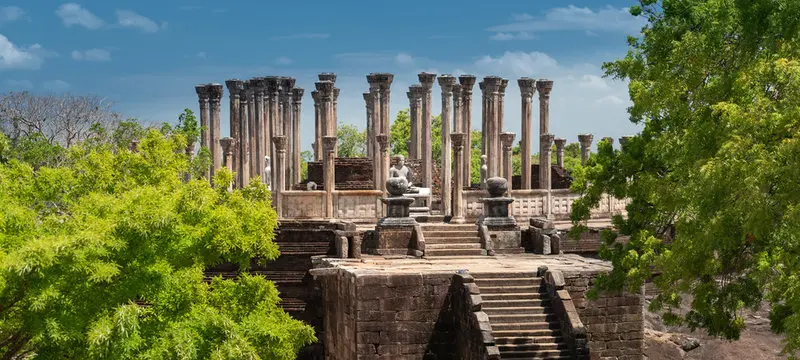Explore Sri Lanka with SoLuxuaryTours – Authentic Journeys, Hidden Treasures & Lasting Memories!
Contact Now !
Alice Roses
London, England
4517 Washington Ave.
Manchester, Kentucky 39495
Hours: 8:00 - 17:00, Mon - Sat
support@SoLuxuaryTravels.com
.webp?alt=media&token=f755cc27-36e2-426b-be85-1b421441e12c)

.webp?alt=media&token=daa477e3-1244-421d-b996-437140d72a67)
.webp?alt=media&token=f09fa4bd-0851-4be0-b5b6-3b2e3cc7b3c7)
.webp?alt=media&token=f755cc27-36e2-426b-be85-1b421441e12c)

.webp?alt=media&token=daa477e3-1244-421d-b996-437140d72a67)
.webp?alt=media&token=f09fa4bd-0851-4be0-b5b6-3b2e3cc7b3c7)
.webp?alt=media&token=f755cc27-36e2-426b-be85-1b421441e12c)
North Central Province
Polonnaruwa, the second great capital of ancient Sri Lanka, stands as a remarkable testament to the island’s medieval glory. Flourishing between the 11th and 13th centuries AD, Polonnaruwa succeeded Anuradhapura as the royal capital after King Vijayabahu I liberated the island from Chola invaders. Under the reign of King Parakramabahu I and later rulers, the city reached new heights in governance, trade, architecture, and irrigation.
This UNESCO World Heritage Site is celebrated for its well-preserved ruins that showcase the artistic and engineering brilliance of the era. The sacred Quadrangle complex, with its temples, shrines, and stupas, reflects the city’s spiritual and cultural importance. Among its highlights are the Gal Vihara statues, where colossal granite carvings of the Buddha in standing, seated, and reclining postures demonstrate extraordinary craftsmanship.
Polonnaruwa, Sri Lanka’s medieval capital, is one of the island’s most captivating cultural treasures. Recognized as a UNESCO World Heritage Site, this ancient city flourished between the 11th and 13th centuries AD and remains one of the best-preserved archaeological marvels in South Asia. It served as the political, economic, and cultural hub following the decline of Anuradhapura, ushering in an era of prosperity and innovation. The city’s golden age is largely attributed to King Parakramabahu I (1153–1186 AD), whose reign transformed Polonnaruwa into a thriving metropolis. His contributions included expansive irrigation systems, monumental architecture, and the establishment of Buddhist monasteries. His belief that “not a drop of water falling from the heavens should be wasted” was realized through the construction of vast reservoirs, the most notable being the Parakrama Samudra. This immense tank, covering over 2,500 hectares, still irrigates surrounding farmland today. At the spiritual heart of Polonnaruwa lies the Quadrangle, a compact yet striking group of religious monuments. Within it stands the Vatadage, an elegant circular relic house, alongside other shrines such as the Thuparama and Lankatilaka. Together, they showcase the city’s devotion to Buddhism and its mastery of stone carving. Perhaps the most awe-inspiring site is the Gal Vihara, where four colossal Buddha statues are carved directly into a granite rock face. Depicting the Enlightened One in meditative, standing, and reclining postures, these sculptures are celebrated as masterpieces of ancient Sinhalese art, radiating serenity and spiritual depth. The secular side of Polonnaruwa is equally impressive. The Royal Palace of Parakramabahu, though now in ruins, is believed to have once contained seven stories and nearly a thousand rooms. Nearby, the Audience Hall and Council Chamber reflect the administrative sophistication of the kingdom. Massive stupas such as Rankoth Vehera and Kiri Vehera further highlight the grandeur of the city’s religious life. Exploring Polonnaruwa today is a journey into the past. The city’s ruins are spread across a vast area surrounded by lush greenery, paddy fields, and reservoirs. Many visitors choose to explore by bicycle, weaving through palaces, temples, and reservoirs at their own pace. This allows for a more intimate encounter with a city that once bustled with monks, traders, and royals. Beyond its historical significance, Polonnaruwa’s enduring legacy lies in its ability to balance spirituality, engineering, and environmental sustainability. It stands as a living reminder of a civilization that thrived through innovation and faith. For modern travelers, Polonnaruwa offers not just a glimpse into Sri Lanka’s medieval glory but also inspiration from a society that valued harmony between humanity, nature, and devotion.
Fill in your details to get more details and Booking.
 (21 x 5 cm) (2).png)